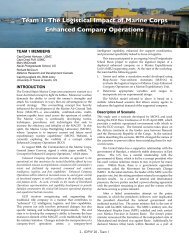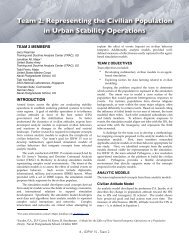pdf file - SEED Center for Data Farming - Naval Postgraduate School
pdf file - SEED Center for Data Farming - Naval Postgraduate School
pdf file - SEED Center for Data Farming - Naval Postgraduate School
You also want an ePaper? Increase the reach of your titles
YUMPU automatically turns print PDFs into web optimized ePapers that Google loves.
Map Beliefs to TCAPF Issues<br />
The next step required the team to map beliefs from the<br />
PAKAF case study to TCAPF issues appended to the<br />
Bayesian belief network. Specifically, the team assessed each<br />
belief node to determine whether it would likely impact any<br />
of the TCAPF issues. For instance, the belief ‘Tolerate<br />
Opium’ from figure 2 would likely have a relational impact<br />
on the population’s stance on irrigation water (depicted as<br />
‘IRRWATER’ in figure 2).<br />
Develop Case Files to Impact Beliefs<br />
The final step in the methodology involved the process of<br />
developing case <strong>file</strong>s that impact beliefs in the Bayesian<br />
belief network. In the CG model, beliefs may be impacted<br />
by events from external actors. For instance, assume the CG<br />
model simulates coalition <strong>for</strong>ces conducting opium<br />
eradication operations. Following this event, the belief<br />
‘Tolerate Opium’ would likely be impacted. Assuming<br />
‘Tolerate Opium’ is mapped to the issue of irrigation water,<br />
opium eradication would affect the population’s issue stance<br />
on irrigation water.<br />
The process of developing case <strong>file</strong>s involved SMEs<br />
completing a questionnaire tailored to the events, population<br />
groups, beliefs, and issues under study. Specifically, SMEs<br />
assessed the impact of each event on each belief from the<br />
perspective of each population group. For instance, the<br />
PAKAF case study modeled rural and urban population<br />
groups. Extending the example above, SMEs might assess<br />
that opium eradication impacts the ‘Tolerate Opium’ belief<br />
more <strong>for</strong> rural dwellers than urban dwellers because rural<br />
dwellers are more likely to engage in opium production than<br />
urban dwellers. The questionnaire also required SMEs to<br />
assess the impact of end node issue stances (to include the<br />
four issues from TCAPF) by event and population group.<br />
RESULTS<br />
The team executed an experiment in the CG model involving<br />
14 factors (namely the events modeled in the PAKAF case<br />
study) and Bayesian belief networks and case <strong>file</strong>s<br />
simulating the TCAPF issues.<br />
The team expects to analyze output from the runs by<br />
comparing CG results to TCAPF results with respect to tribal<br />
affiliation and occupation. The PAKAF case study modeled<br />
population dimensions according to five categories, including<br />
tribal affiliation and occupation. TCAPF data also captured<br />
respondent demographics by tribal affiliation and<br />
occupation. Assuming that TCAPF data is ‘ground truth’ (or<br />
the baseline condition), comparing CG model output against<br />
TCAPF output <strong>for</strong> these demographic groups will provide a<br />
measure of validation <strong>for</strong> the CG model. Results of this<br />
analysis will be published in thesis research scheduled <strong>for</strong><br />
June 2010.<br />
CONCLUSIONS<br />
The team developed and successfully implemented a sound<br />
methodology <strong>for</strong> augmenting a preexisting CG scenario with<br />
TCAPF data. Our team’s contribution represents a starting<br />
point <strong>for</strong> integrating a popular data collection framework<br />
with the CG model.<br />
Recommendations <strong>for</strong> further research include:<br />
• Improving the CG model to include population<br />
migration capability. This capability may enable<br />
analysts to model and explore factors impacting<br />
TCAPF question #1 data: “Have there been changes<br />
in the village population in the last year?”<br />
• Utilizing the CG model to generate simulated TCAPF<br />
data. The methodology described in this report<br />
facilitates generating TCAPF data from CG.<br />
Specifically, the Bayesian belief networks appended<br />
with TCAPF issues enable analysts to ‘poll’ CG<br />
entities following model execution to determine issues<br />
of greatest interest. This capability would be useful<br />
during training exercises and tactical wargames, such<br />
as TRAC’s ‘Irregular Warfare Tactical Wargame.’<br />
BIBLIOGRAPHY<br />
[4] Alt, Jonathan K., Leroy A. ‘Jack’ Jackson, David Hudak,<br />
and Stephen Lieberman, “The Cultural Geography<br />
Model: Evaluating the Impact of Tactical Operational<br />
Outcomes on a Civilian Population in an Irregular<br />
Warfare Environment.” Journal of Defense Modeling<br />
and Simulation: Applications, Methodology,<br />
Technology, 2009.<br />
[5] Department of the Army, Headquarters. "FM 3-24,<br />
Counterinsurgency." Washington, DC: Department of<br />
the Army, Headquarters, December 2006. 1-14..<br />
Poster Session<br />
45 - IDFW 20 - Team 12




